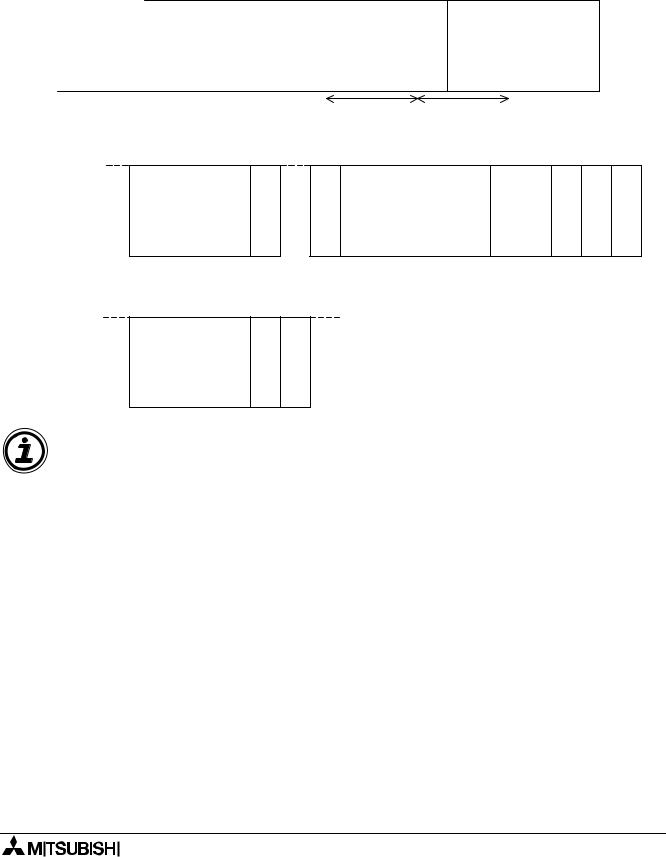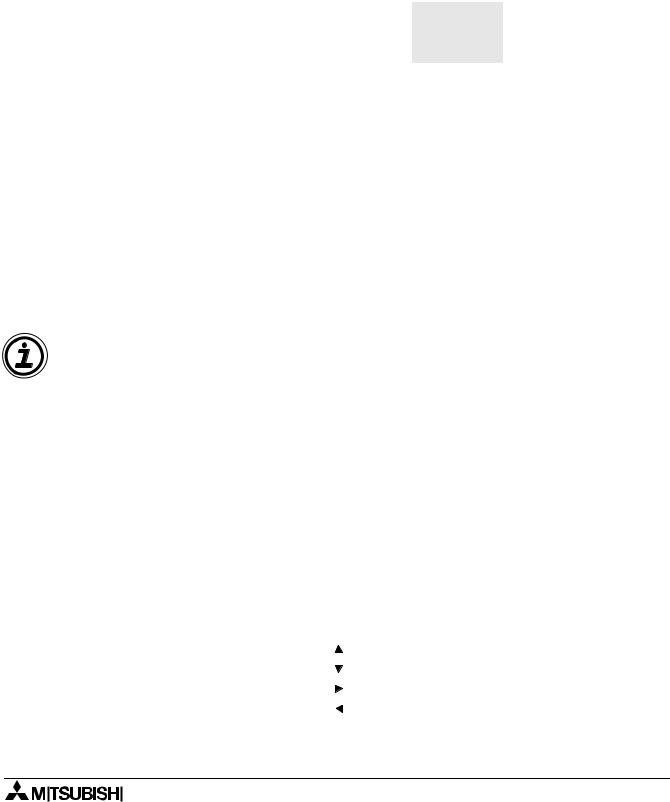
- •Table of Contents
- •1. Communication Capabilities
- •1.1 System Configurations
- •1.1.1 Send an SMS Message to a Mobile Phone
- •1.1.2 Receive the Short Message from a PC and phone
- •1.1.3 Detect The Phone Ringing
- •1.1.5 Program/monitor from remote PC using a GSM Modem
- •1.1.6 Program/Monitor from remote PC using a standard Modem
- •1.1.7 RS - 232C Straight Cable
- •1.2 Dedicated Protocol Communication
- •1.2.1 Dedicated Protocol Configuration
- •2. SMS/SMR/CD Fanctions and the Modem Setting
- •2.1 Set the parameters of the GSM modem from VLS software.
- •2.1.1 GSM & Serial Communication Dialog Box
- •2.1.2 The “Initialize Modem...” Setting
- •2.2 The GSM/SMS Function Block
- •2.2.1 The Short Message Service (SMS)
- •2.2.2 SMS Setting Dialog Box
- •2.3 The SMR Function Block
- •2.3.1 The Short Message Receiving (SMR)
- •2.4 The CD Function Block
- •2.4.1 Call Detect (CD)
- •2.5 Set GSM Modem Parameters from the Front Panel Keys
- •2.5.1 ComFormat
- •2.5.2 The GSM Init Command (GSM Initialization Command)
- •2.5.3 Pin Code
- •2.5.5 GSM Status
- •2.6 Characters in GSM Protocol
- •2.6.1 The GSM Character Table
- •2.6.2 French GSM Characters
- •2.6.3 Italian GSM Characters
- •2.7.1 SMS Function Block Example
- •2.7.2 SMR Function Block Example
- •2.7.3 CD Function Block Example
- •3. Remote Access
- •3.1 GSM Remote Access
- •3.1.1 Set Parameters from the VLS software
- •3.1.2 GSM & Serial Communication Dialog Box
- •3.1.3 GSM Modem Settings
- •3.1.4 The GSM Init Command (GSM Initialization Command)
- •3.1.5 Command Setting
- •3.1.6 Delay Time
- •3.1.7 GSM Remote Command
- •3.1.8 The PIN Code
- •3.2 Standard Modem Remote Access
- •3.3 Set Parameters from VLS software
- •3.3.1 GSM & Serial Communication Dialog Box
- •3.3.2 Standard Modem Settings
- •3.3.3 The Command Setting
- •3.3.4 The Delay Time Setting
- •3.3.5 Standard Preconfigured Modems
- •4. SMS Messaging Diagnostics
- •4.1 Check points for Mobile Phone Communication Problems
- •4.3 GSM Status
- •4.3.1 GSM Status
- •4.3.2 CME Error
- •4.3.3 CMS Error
- •4.3.4 Signal Strength (Sigstreng)
- •5. Computer Link - Dedicated Protocol
- •5.1 Data Flow by Link
- •5.2 Configuration Diagram
- •5.3 How to read Dedicated Protocol
- •6.1 GSM and Serial Communication Setting
- •6.2 Function Blocks
- •6.3 Settings for Dedicated Protocol - Front Panel Keys
- •6.3.1 Top Menu Setting/Serial Com Settings
- •6.3.2 The “Other Com” Settings
- •6.3.3 The Comformat (Communication Format)
- •6.3.4 Data Length
- •6.3.5 Parity
- •6.3.6 Stop Bits
- •6.3.7 Baud Rate
- •6.3.8 Default
- •6.3.9 Station Number
- •6.3.10 Link Block
- •6.3.11 Function Block Bit and Word Data
- •7. The Command String
- •7.1 Format “A”
- •7.2 Format “B” Message
- •7.3 Control Protocol elements
- •7.3.1 Control Codes
- •7.3.2 No. of Communication Bytes
- •7.3.3 Format Number
- •7.3.4 Station Number
- •7.3.5 Command
- •7.3.6 Number of Devices
- •7.3.7 Device Code
- •7.3.8 Device Number
- •7.3.9 Device Status
- •7.3.10 Sum Check
- •7.3.11 Error Codes
- •7.4 Communication Timing Chart
- •7.4.1 Read/Write Data from the Controller
- •7.4.2 Communication Time
- •7.5 Character Area Data Transmission
- •7.5.1 Read Data Transmission
- •7.5.2 Write Data Transmission
- •7.5.3 Time Switch Data Transmission
- •7.6 Commands
- •7.6.1 Communication Line Check
- •7.6.2 Read Command
- •7.6.3 Write Command
- •7.6.4 Remote RUN/STOP Operation
- •7.6.5 Time Switch Settings
- •7.6.6 VLS Time Switch Settings (Sample)
- •7.6.7 RTC Read Command
- •7.6.8 RTC Write Command
- •7.7 Sample Visual Basic program
- •8. Dedicated Protocol Error Diagnostics
- •8.1 Check points for Dedicated Protocol

α2 Simple Application Controllers |
The Command String 7 |
7.3.6Number of Devices
The Number of Devices is restricted by total number of Communication Bytes. The Transmit/ Receive data message contains a maximum of 250 bytes. Thus, caution must be taken when reading BIT/WORD data. Refer to the Note below for detailed caution information.
Format B - READ message
|
S |
commNo. |
bytes |
FormatNo. |
StationNo. |
Command |
No.of devices |
|
codeDevice |
DeviceNo. (LB) |
DeviceNo. (HB) |
|
codeDevice |
|
T |
|
|
|
|
|
|
|
|
|
|
|
|
|
X |
|
|
|
|
|
|
|
|
|
|
|
|
Computer |
|
|
|
|
|
|
02H |
|
|
|
|
|
|
α2 Controller |
|
|
|
|
|
|
02 = |
|
01*1 |
|
+ |
||
DeviceNo. (LB) |
DeviceNo. (HB) |
E |
checkSum |
(LB) |
checkSum (HB) |
|
|
T |
|
|
|
|
|
X |
|
|
|
|
|
|
|
|
|
01*1 (devices)
S |
commNo. |
bytes |
FormatNo. |
StationNo. |
T |
|
|
|
|
X |
|
|
|
|
|
|
|
|
|
or
S |
commNo. |
bytes |
FormatNo. |
StationNo. |
T |
|
|
|
|
X |
|
|
|
|
|
|
|
|
|
Complete flag
N A K
Error Code
S T X
No. comm bytes |
Format No. |
Station No. |
Command |
No. of devices |
|
|
|
|
|
|
02H |
|
|
|
|
|
|
Device status |
Device status |
|
|
E T X
Sum check (LB) Sum check (HB)
Note: Format B cautions
1 ) READ Message - BIT data
The maximum number of BIT devices that can be read at any one time is restricted by the maximum number of communication bytes (250 bytes) contained in a single message. Each device is represented by the Device code, Device No, (LB) and Device No. (HB).
(Max No. of Comm. bytes - (Format No. + Stat No. + Command + No. of Devices)) / (Device code + Device No(LB) + Device No. (HB)) =
(250 - 4) / 3 = 246 / 3 = 82
Therefore, the user can read 1 ~ 82 BIT devices at any one time.
2 ) READ Message - WORD data
The maximum number of WORD devices that can be read at any one time is restricted by the maximum number of communication bytes (250 bytes) contained in a single message. Each device is represented by the Device code, Device No, (LB) and Device No. (HB).
(Max No. of Comm. bytes - (Format No. + Stat No. + Command + No. of Devices)) / (Device code + Device No(LB) + Device No. (HB)) =
(250 - 4) / 3 = 246 / 3 = 82
Therefore, the user can read 1 ~ 82 WORD devices at any one time.
7 - 9

α2 Simple Application Controllers The Command String 7
3 ) WRITE Message - BIT data
The maximum number of BIT devices that can be written at any one time is restricted by the maximum number of communication bytes (250 bytes) contained in a single message. Each device is represented by the Device code, Device No, (LB), Device No. (HB) and Device Status (1byte).
(Max No. of Comm. bytes - (Format No. + Stat No. + Command + No. of Devices)) / (Device code + Device No(LB) + Device No. (HB) + Device Status) =
(250 - 4) / 4 = 246 / 4 = 61
Therefore, the user can write 1 ~ 61 BIT devices at any one time.
4 ) WRITE Message - WORD data
The maximum number of WORD devices that can be written at any one time is restricted by the maximum number of communication bytes (250 bytes) contained in a single message. Each device is represented by the Device code, Device No, (LB), Device No. (HB), Device Status (LB) (1byte) and Device Status (HB) (1byte).
(Max No. of Comm. bytes - (Format No. + Stat No. + Command + No. of Devices)) / (Device code + Device No(LB) + Device No. (HB) + Device Status(LB) + Device Status(HB)) =
(250 - 4) / 5 = 246 / 5 = 49
Therefore, the user can write 1 ~ 49 WORD devices at any one time.
5 ) Time Switch READ Message.
The READ operation of a Time Switch settings follows the identical structure to reading a Communication Word device in Format B. The maximum number of Time Switch devices that can be read at any one time is restricted by the maximum number of communication bytes (250 bytes) contained in the reply message.
(Max No. of Comm. bytes - (Format No. + Stat No. + Command + No. of Devices)) / (RTC0 + RTC1 + RTC2 + RTC3) =
(250 - 4) / 4 = 246 / 4 = 61
Therefore, the user can read 1 ~ 61 Time Switch settings at any one time. Refer to section 7.6.5 for further infromation concerning Time Switch settings.
6 ) Time Switch WRITE Message
The maximum number of Time Switch devices that can be read at any one time is restricted by the maximum number of communication bytes (250 bytes) contained in a single message. Each device is represented by the Device code, Device No, (LB), Device No. (HB), RTC+0, RtTC+1, RTC+2 and RTC+3.
(Max No. of Comm. bytes - (Format No. + Stat No. + Command + No. of Devices)) / (Device code + Device No(LB) + Device No. (HB) + RTC0 + RTC1 + RTC2 + RTC3) = (250 - 4) / 7 = 246 / 7 = 35
Therefore, the user can write 1 ~ 35 Time Switch settings devices at any one time. Refer to section 7.6.5 for further infromation concerning Time Switch settings.
A mixture of Time Switch, BIT and WORD data can be sent via one Transmit message.
7 - 10

α2 Simple Application Controllers |
The Command String 7 |
7.3.7Device Code
Each type of Bit or Word Device has a device code which corresponds to a memory location in the α2 series controller. Locations for the System Bits, Inputs, Outputs, Keys, Link Input, and
Link Output are permanent but the Function Block settings (Communication Bit and Word Devices) must be set in the “Options/Dedicated Communication” dialog box in the VLS software. Remember to set aside some memory in the same dialog box for these devices. Refer to section ** for VLS settings.
Table 7.8: Device Code and Access Data
|
Device Code |
|
Device Range |
|
|
|
Device Name |
Device Range |
(Hex) |
Read |
Write |
||
(Hex) |
(Decimal) |
(HB LB)*3 |
Access |
Access |
||
|
||||||
|
|
|
|
|
|
|
System Bit (M) |
40 |
1 ~ 24 |
00 01 ~ 00 0E |
Yes |
No |
|
|
|
|
|
|
|
|
Input Terminal (I) |
41 |
1 ~ 15 |
00 01 ~ 00 0F |
Yes |
Yes |
|
|
|
|
|
|
|
|
External Input (EI) |
41 |
129 ~ 132 *1 |
00 81 ~ 00 84 |
Yes |
Yes |
|
|
|
|
|
|
|
|
Output Terminal (O) |
42 |
1 ~ 9 |
00 01 ~ 00 09 |
Yes |
Yes |
|
|
|
|
|
|
|
|
External Output (EO) |
42 |
129 ~ 132 *2 |
00 81 ~ 00 84 |
Yes |
Yes |
|
|
|
|
|
|
|
|
Key Input (K) |
44 |
1 ~ 8 *5 |
00 01 ~ 00 08 |
Yes |
Yes |
|
|
|
|
|
|
|
|
Link Input (E) |
45 |
1 ~ 4 |
00 01 ~ 00 04 |
Yes |
Yes |
|
|
|
|
|
|
|
|
Link Output (A) |
46 |
1 ~ 4 |
00 01 ~ 00 04 |
Yes |
Yes |
|
|
|
|
|
|
|
|
Control Device (N) |
47 |
1 ~ 4 |
00 01 ~ 00 04 |
Yes |
Yes |
|
|
|
|
|
|
|
|
Analog In |
61 |
1 ~8 |
00 01 ~ 00 08 |
Yes |
No |
|
|
|
|
|
|
|
|
Communication |
48 |
1 ~ 100*4 |
00 01 ~ 00 64 |
Yes |
Yes |
|
Bit Device (CB) |
||||||
|
|
|
|
|
||
|
|
|
|
|
|
|
Communication |
69 |
1 ~ 100*4 |
00 01 ~ 00 64 |
Yes |
Yes |
|
Word Device (CW) |
||||||
|
|
|
|
|
||
|
|
|
|
|
|
|
|
|
|
|
|
|
Note:
*1 The settings for the α2 controller input extension boards: Where EI 01~04 for AL2-4EX and AL2-4EX-A2 are 129 - 132 respectively.
*2 The settings for the α2 controller output extension boards: Where EO 01~04 for AL24EYR and AL2-4EYT are 129 - 132 respectively.
*3 Each hexadecimal value is represented by a HB and LB. Where HB is the higher byte and LB is the lower byte.
*4 The full 100 data range can only be accessed if the appropriate memory has been allocated from either the front panel keys or VLS software.
*5 key input numerical order
Input No. (hex) |
Key |
|
|
|
|
0001 |
“OK” |
|
|
|
|
0002 |
“ESC” |
|
|
|
|
0003 |
“+” |
|
|
|
|
0004 |
“-” |
|
|
|
|
0005 |
“ |
” |
|
|
|
0006 |
“ |
” |
|
|
|
0007 |
“ |
” |
|
|
|
0008 |
“ |
” |
|
|
|
|
|
|
7 - 11

α2 Simple Application Controllers |
The Command String 7 |
7.3.8Device Number
The Device Number is used in conjuction with the Device Code. Once the Device has specified what the internal device represents, then the Device Number is used to select the appropriate device from the range mentioned above. Each Device Number is comprised of 2 bytes:
Lower byte (LB) Higher byte (HB)
Example - The user wants to check the status of Input 11. Converting input 11 to a four digit Hexadecimal number 00 0B. The High Byte (HB) = 00. The Low Byte (LB) = 0B. Thus, the user will enter the Device Code followed by 0B 00 to read/write data from/to Input 11.
7.3.9Device Status
1) BIT Device - A single byte is allocated to the Device Status when used for both READ and WRITE operations.
Table 7.9: Byte representation of the BIT status
State |
Device Status (Hex) |
ON |
01 |
|
|
OFF |
00 |
|
|
|
|
2 ) WORD Device - Two bytes are allocated to the Device Status when used for both READ and WRITE operations. Therefore, both the lowerbyte (LB) and Higherbyte (HB) of the device status when used in conjunction with a WORD application can allow the user to enter a maximum value of: 32767 (decimal) and minimum value of -32768 (decimal). The counter function block has a minimum value of 0 and the PWM function block has a minimum value of Period Time.
7 - 12
